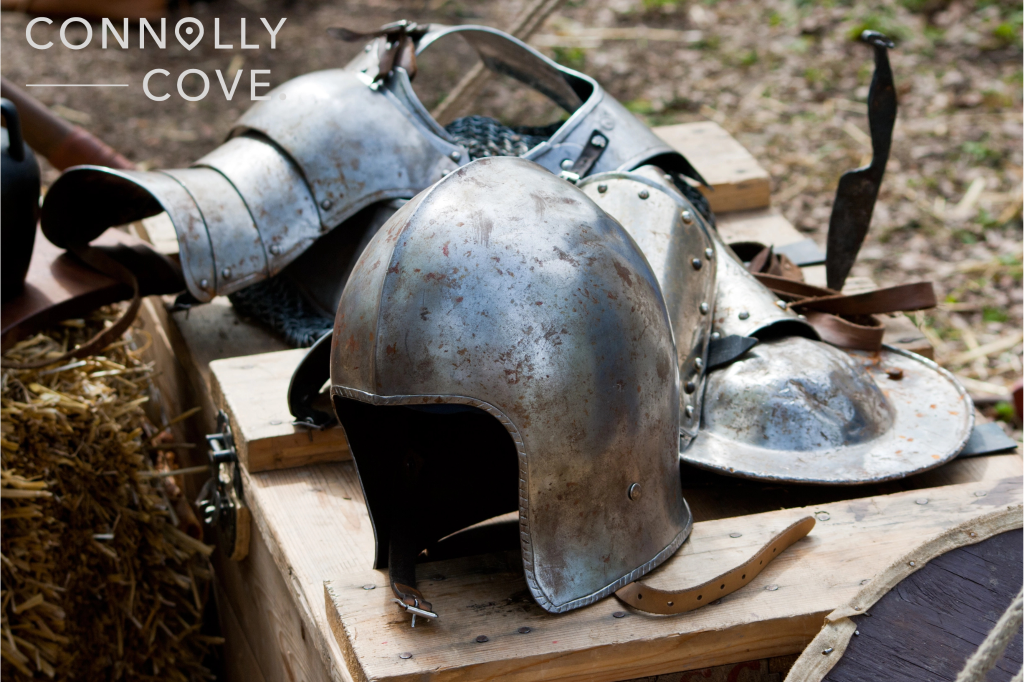The Rise and Fall of the Pike: From Ancient Warfare to Renaissance Revival

Updated On: April 07, 2024 by doaa
Have you ever been completely engrossed in the gripping stories of historical battles and fascinated by the wide range of weapons used? I certainly have. However, my interest peaked when I came across the pike weapon – a commanding, long-reaching spear that dominated European battlefields from the Medieval era to the 17th century.
It was a powerful weapon and played a crucial role in the formations and strategies used by infantry during warfare. Its formation, with pikemen gripping their pikes firmly, provided a formidable defence against cavalry and could be used aggressively in close combat.
Key Takeaways
- The pike had a simple and practical design, featuring a long wooden shaft with a sharp steel point at the tip, allowing soldiers to strike from a safe distance.
- Its versatility was demonstrated through its use in formations like the pike square and its combination with firearms in pike and shot tactics. These tactics revolutionised warfare at the time.
- While technological advancements eventually made the pike obsolete, its legacy as a robust and adaptable polearm in European warfare remains undeniable.
History of the Pike Weapon in Europe
The pike weapon has a long and storied history in Europe, dating back to ancient times.
Ancient Europe Usage
Pikes were part of old Europe. People used them in war a lot. Soldiers knew the pike as a long spear made from ash wood. It was sharp and could reach up to eighteen feet! This gave soldiers a big help when fighting enemies.
They had more reach and power with this weapon than others at that time.
Medieval Revival
During the Middle Ages, interest in using them as weapons in European warfare was resurgent, particularly by Swiss mercenaries renowned for their skilled use. This revival occurred because knights on horseback were losing their dominance on the battlefield.
Foot soldiers armed with pikes became a formidable force against heavily armoured cavalry. Its formations tended to create a barrier known as a “pike hedge,” with the front presenting a wall of pikes, making it difficult for cavalry to penetrate. The pike’s long reach allowed infantry to keep their distance from charging horses, while its sharp point could easily penetrate armour.
Renaissance Heyday
During the Renaissance, the pike weapon reached its heyday as a powerful and versatile weapon in European warfare. This period saw significant advancements in military tactics and equipment.
Its design allowed soldiers greater control over their weapons, increasing their effectiveness in combat. Its versatility made it a formidable polearm during this time, showcasing its power and influence on historical warfare.
Compared with Other Renaissance Weaponry, Halberd and Bayonet-Equipped Muskets
The pike, halberd, and bayonet-equipped muskets, all prominent in Renaissance warfare, each had distinct features and uses on the battlefield. Comparing them provides insight into their respective tactical roles and effectiveness:

Pike
- Design: A spear with a pointed metal tip is typically 10 to 25 feet long.
- Usage: Primarily in large formations (phalanxes) for defence against cavalry and infantry charges. Its length was a significant advantage in keeping enemies at a distance.
- Advantages: Excellent in formation for creating impenetrable walls of spear points; effective against cavalry.
- Disadvantages: Cumbersome and less effective in close combat or rugged terrain; required significant training and discipline to use effectively in formation.
Halberd
- Design: A combination of spear, battle axe, and hook, mounted on a long shaft, usually around 5 to 6 feet long.
- Usage: Versatile in offensive and defensive roles; used by infantry to counter foot soldiers and cavalry.
- Advantages: Multi-functional – could thrust like a spear, chop like an axe, and hook enemy weapons or dismount riders. It’s more manageable in close quarters than a pike.
- Disadvantages: Shorter reach compared to pikes; required skilled handling due to its multiple functions.
Bayonet-Equipped Muskets
- Design: Firearms (muskets) equipped with a bayonet, a blade that could be fixed to the muzzle for close combat.
- Usage: Provided infantry with a ranged weapon and a close-combat option, transitioning smoothly between shooting and stabbing.
- Advantages: Versatility in switching between ranged and melee combat; reduced the need for separate pike units as musketeers could defend themselves in close quarters.
- Disadvantages: Bayonets were less effective than pikes or halberds in melee combat; muskets were relatively inaccurate and slow to reload.
Tactical Evolution
- Pike to Halberd: The transition from pike to halberd reflects a shift towards more versatile and adaptable infantry weapons, suitable for various combat scenarios.
- Halberd to Bayonet: The emergence of bayonet-equipped muskets marked a significant shift in warfare, emphasizing ranged combat. As firearms improved, the role of traditional melee weapons diminished, though bayonets remained helpful in close encounters.
The Versatility and Power of the Weapon
The pike weapon was a highly versatile and powerful polearm crucial in medieval and Renaissance European warfare.
Design
The design of the weapon was both simple and effective. It featured a long wooden shaft, usually made from ash, ranging from 10 to 20 feet long. At the tip of this polearm was a small leaf-shaped steel point, perfect for thrusting attacks.
Its length allowed soldiers to keep their enemies at a safe distance while still being able to strike effectively. The design also increased leverage, giving soldiers greater control over the weapon during combat.
With its sturdy construction and strategic design, the pike proved a versatile and powerful polearm on European battlefields throughout history.
Tactics
It was often used in specific formations called pike squares or phalanxes in battle. These formations consisted of rows of pikemen standing closely together, creating a wall-like structure.
The long reach of pikes allowed them to thrust and attack enemies from a safe distance, while the tight formation protected against cavalry charges. It required skilled coordination and discipline to maintain these formations during combat.
Another vital tactic was its combination with firearms. During the Renaissance, soldiers equipped with muskets and bayonets would stand behind a line of pikemen.
The pikemen would protect the musketeers as they reloaded their weapons after firing a shot. This tactic allowed for both long-range shooting and close-combat defence.
It has been an essential weapon on European battlefields for centuries. Its role in medieval warfare showcased its power as an infantry weapon, while its incorporation into pike and shot tactics demonstrated its adaptability to changing military strategies.
End of the Pike
Throughout the centuries, significant changes in warfare took place, ultimately leading to the decline of the pike as an influential weapon on the battlefield. The pike, once a mainstay in European warfare, became obsolete due to advancements in firearms and shifts in military tactics. The traditional use of pike formations and the reliance on foot soldiers armed with pikes gradually gave way to new strategies and technologies, rendering the pike less relevant in modern warfare.
Changes in Warfare Leading to the Decline of the Pike
The advent of gunpowder and the widespread use of firearms revolutionised warfare, making traditional pike formations vulnerable to long-range attacks. As armies transitioned toward employing combined arms tactics, which integrated firearms with other infantry units, the role of the pike diminished. Furthermore, the development of new methods, such as pike and shot formations, saw the pike being used in conjunction with firearms but gradually losing prominence as firearms became more advanced and versatile.
Legacy of the Pike in Military History
Despite its obsolescence in contemporary warfare, the pike left a lasting legacy in military history. Its influence on infantry tactics and formations persisted, with various military innovations being inspired by the pike’s design and tactical use. The pike’s role in shaping medieval warfare and its eventual transition into ceremonial and symbolic significance within military formations showcased its enduring impact despite the evolution of warfare.
In conclusion, the pike weapon was a fearsome and adaptable tool in European warfare. Its long reach and sharp point made it compelling for thrusting attacks from formations like the Pike Square. With its design allowing for increased control, the pike proved its power and versatility on the battlefield throughout history. This formidable polearm will be remembered as a crucial weapon in European warfare.
FAQs
What is a Pike Weapon?
A pike is a type of weapon that was widely used in medieval and Renaissance Europe. It is essentially a very long spear, historically used by infantry for offensive and defensive purposes. Here are some key aspects of the pike.
How did Pike infantry use this weapon?
Pike infantry, often organised into large formations, used the pike weapon in several distinct ways, leveraging its length and the collective strength of the unit. The key tactics and uses include Phalanx Formation, Defensive Posture, Offensive Pushes, Combined Arms Tactics, Rotation and Stamina Management, and Adaptation in Terrain and Situations.
How does the pike compare with other Renaissance weaponry like Halberd or Bayonet-equipped muskets?
The Pike weapon, like the Halberd or bayonet-equipped muskets, played a leading role in European Warfare due to its substantial reach and might.
Are there any particular parts of history where these weapons were used more often?
Yes! The Pike, along with other similar weapons, made quite an impact during medieval times through the Renaissance periods as an essential tool in long-range combat.






